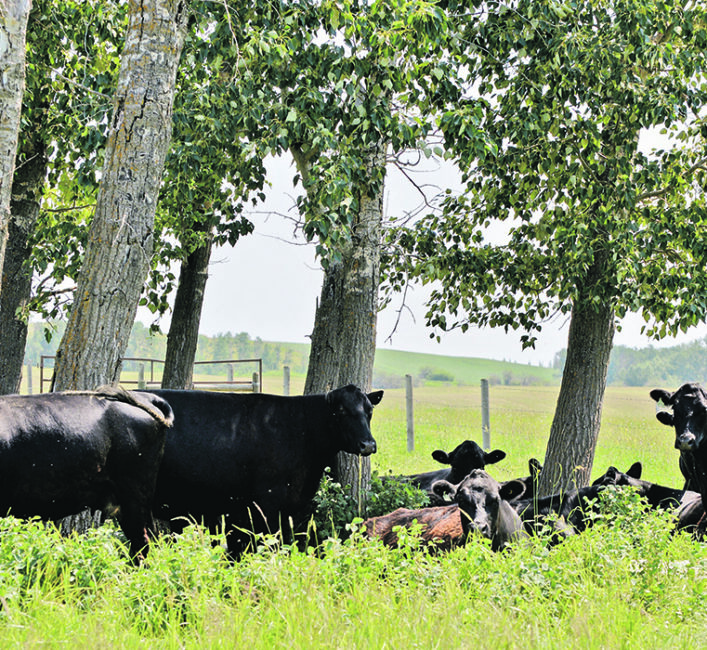Study suggests ways to reduce beef emissions

A recent study by researchers at Colorado State University looked at different strategies for reducing greenhouse gasses emitted during beef production.
Researchers found the industry could achieve a 50 percent reduction in certain regions by enhancing some ranch management practices.
However, in regions where GHG emission reduction practices are already in place, the gains are less.
The strategies were grouped into eight categories that included conventional versus integrated field management, intensive rotational grazing, improved feed/supplements, breed comparisons, cattle life cycle management, feedlot versus grazing, fertilizer use changes and organic beef production.
Globally, cattle produce 78 percent of total livestock greenhouse gas emissions.
According to lead author of the study Daniela Cusack, assistant professor at the university’s department of ecosystem science and sustainability, there are management practices that could substantially reduce the industry’s climate change footprint.
Researchers found a 46 percent reduction in net GHG emissions per unit of beef at sites using carbon sequestration management strategies on grazed lands. Those strategies included using organic soil changes and restoring trees and perennial vegetation to degraded forests, woodlands and riverbanks.
The researchers analyzed 292 comparisons of “improved” versus “conventional” beef production systems across Asia, Australia, Brazil, Canada, Latin America and the U.S.
Brazil’s beef production showed the greatest potential for reducing emissions.
Carbon sequestration and improved production efficiency in Brazil could lead to a 57 percent carbon emission reduction. Specific strategies include improved feed quality, better breed selections and enhanced fertilizer management.
Field management offered the greatest impact and it included intensive rotational grazing structures, the addition of soil compost, reforestation of degraded areas and selectively planting forage plants bred for sequestering carbon in soils.
“My home country of Brazil has more than 52 million hectares (128 million acres) of degraded pastureland, (which is) larger than California,” said Amanda Cordeiro, co-author of the study and a graduate student at CSU.
“If we can aim for a large-scale regeneration of degraded pastures, implementation of silvo-agro-forestry systems and adoption of other diversified local management strategies to cattle production, Brazil can drastically decrease carbon emissions.”
In the U.S., the researchers found that strategies like integrated field management and intensive rotational grazing actually reduced beef carbon emissions by more than 100 percent, or net-zero emissions, in a few grazing systems.
“Many ranchers and producers are working to continually improve their management and use practices that reduce emissions,” said Cusack. “At the same time, there is likely considerable room across all regions for improving management practices on more acres. More work is needed to understand where producers are using innovative practices and where there is opportunity for management improvements.”
According to Agriculture Canada, 10 percent of Canada’s GHG emissions are from crop and livestock production, excluding emissions from fossil fuel use for fertilizer production. Agriculture also helps slow climate change by storing carbon on agricultural lands in soil, vegetation and trees.
Cusack said their analysis shows opportunities to improve the efficiency and sustainability of beef production. However, she said widespread net-zero emissions will not be reached without further innovation and strategies beyond land management and increased growth efficiency.
“The largest potential reductions in beef GHGs came from sustainable land management to increase carbon sequestration in tandem with beef production,” she said. “In some regions, increased growth efficiency per unit of GHG produced also has great promise, but in other regions these efficiency approaches already appear quite advanced and the lower hanging fruit is in management strategies.
“The work emphasizes the importance of tailoring solutions for the specific characteristics of a place. Even within the regions we explored in the paper, some management approaches may be more or less effective depending on the climate, soils, and management histories of a particular ranch.”
In Australia, direct livestock emissions account for about 70 percent of GHG emissions by the agricultural sector and 11 percent of total national GHG emissions, making Australia’s livestock the third largest source of greenhouse gas emissions after the energy and transport sectors.
While the report refers to a 46 percent reduction in emissions through carbon sequestration and growth efficiency at the research sites studies, Cusack believes there is great potential of increased adoption of these sustainability practices elsewhere.
“Many of these practices not only reduce GHGs but also can reduce costs,” she said.
Particularly in regions with new or active carbon markets, there could also be an economic incentive for the carbon sequestration strategies. However, the potential for restoring soil carbon is likely not universal. Sites that have lost soil organic matter from erosion or tillage will be more likely to see carbon sequestration gains.
While the research shows a reduction in the carbon footprint of beef production by using improved management strategies, scientists are cautious because of limited data on a global scale to back up their findings.
At this stage of the study, researchers did not explore ranchers’ perceptions of the different management approaches or assess current adoption rates of practices. But Cusack said that it will be important to understand where opportunities exist.
“I am starting on a project to do this in Colorado together with social scientists,” she said. “We will assess carbon sequestration in different production sites and assess adoption feasibility.”
The study was published recently in Global Change Biology.
Source: producer.com

